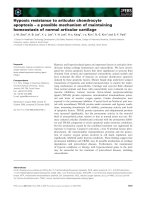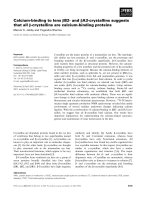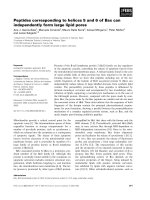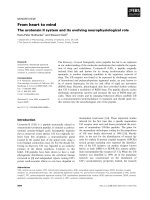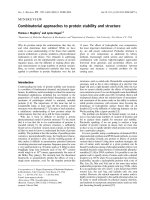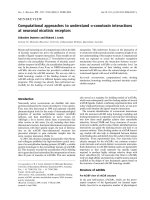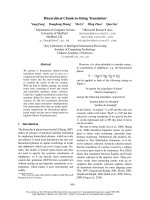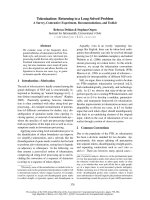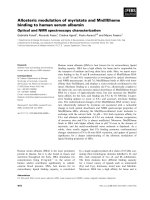Báo cáo khoa học: "HELPFUL ANSWERS TO MODAL AND tlYPOTHETICAL QUESTIONS" docx
Bạn đang xem bản rút gọn của tài liệu. Xem và tải ngay bản đầy đủ của tài liệu tại đây (742 KB, 6 trang )
HELPFUL ANSWERS TO MODAL AND tlYPOTHETICAL QUESTIONS
Amre De Roeck, Richard Ball, Keilh Brown, Chris Fox, Marjolein Groefsema, Nadhn Obeid, Ray Turner
University of Essex
England
emaih (janet)
1.0 ABSTRACT,
This paper describes a computational pragmatic model which is
geared towards providing helpful answers to modal and hypothet-
ical questions. The work brings together elements from fonnal.
semantic theories on modality m~d question answering, defines a
wkler, pragmatically flavoured, notion of answerhood based on
non-monotonic inference aod develops a notion of context, with-
in which aspects of more cognitively oriented theories, such as
Relevance Theory, can be accommodated. The model has been
inlplemented. The research was fundexl by ESRC grant number
R000231279.
Keywords:Semantics, Pragmatics
2.0 INTRODUCTION.
Answers people give to questions have two basic properties:
they may vary dependitig on the situation a question is asked in,
and, especially if the answer is negative, they aim to be "helpful".
The context-sensistivity of answering seems obvious and in no
need of further demonstration. What precisely constitutes "help-
fidness" is harder to pin down. Modal and hypothetical questions
offer an interesting mea for investigating "helpfulness". Suppose
A and B are going to a party and are discussing how they might
travel. Suppose A asks B
Cat, youdrive.?
B is correct but perverse
to respond ~ if he knows how to drive, has a valid licence but
has no car, or if he has a car but he has lent it to someone. A more
helpful answer might be
No. because 1 haven't got a car.
Note
here that there is a range of "correct" answers, some of which are
Ye___~s:
for instance
Yes, I hww how to drive, Yes, ! lutve a licence,
even
Yes, I have a car',
and some of which are N._oo, as in
No, I ha-
ven't got a car" tonight. The
range includes
No, but ! cat, ask tO
borrow my wife's car,
or even
Yes, ill .can get mF car back
which
establishes a link with hypothetical questions. Note also that, for
each of these "correct" aqswers, we can imagine contexts in
which they would be "helpful".
Little is known ahout the nature of questions and their relation-
ship to appropriate answers, or about how ,such answers can be
computed given some information about what the answerer
knows. Some theories, mainly emerging from the Men*ague tra-
dition (see Groeneudijk and Stockhof 119841), attempt to define
"sema,tic" answerhood (see section 2.2), but fall short when
tackling the pragmatic aspect of helpful answers. Other theories
lSperber & Wilso, 19861 offer interesting pragmatic insights but
their formulation does not allow for a straightforward hnplemen-
ration. Furthermore, the problem of answering modal and hypo-
thetical questions is a compounded one which touches on a host
of issues including quantification, intensionality, partiality, belief
revision, propositional attitudes, etc.
Our research aimed to draw up a formally specified and compu-
rationally feasible pragmatic theory which could accommodate
formal semantic views on answerhood as well as intuitive in-
sights into "helpfulness" and its dependence on context (such as
offered by Relevaoce Theory [Sperber and Wilson 19861). Fur-
thennore, the model is rigourously constrained as it must be test-
ed by an implementation over some knowledge base representing
what an agent knows.
This paper is intended as an overview of the computational
model. As such it (Ices not provide an in-depth account of all as-
pects of the investigation; in particular, it does not attempt to
give
a formal account of a basic theory of pragmatics, which is avail,
able elsewhere [Ball et al 19901. Rather, we sketch the back-
ground to the problems involved in providing helpful answers tO
modal and hypothetical questions as a review of the relevant liter-
ature aml its perceived shortcomings. We will then proceed to
outline the intuitions behind our approach to a model of pragmat.
ics aod its in~plementation, and explain how it accommodates
helpful answers to modal and hypothetical questions. An exam-
ple is presented.
3.0 IIELPFULNESS, MEDALS AND QUESTIONS
Though tile problem of helpfully answering modal questions
touches on many issues, four particular points need to be ad,
dressed.
3.1 Modality.
When looking at the example set out in the introduction, the
question arises whether the range of "correct" answers to some
extent corresponds to ambiguity (ability/possibility) residing in
the ,nodal can. Indeed, a large proportion of the literature on mo-
dality concerns the view that medals are polysemous, depending
on the kind and degree of modality they express (epistemic, deon.
tic, etc.) [Palmer 1979, 1986; Quirk et at. 19851. Usually, at-
tempts are made to identify modal "primitives"
(ability,
permission, etc)
and 1o analyse modal constructs as ambiguous
over several "literal" meanings involving these primitives. Invari-
ably, polysemie reduetionist approaches to modal constructs run
into problems: given any classification of core types of modality,
it is often hnpossible to determine which reading is involved in
any particular example [Coates 1983 versus Walton 1988].
Kratzer [19771 lakes another view. She presents a unified anal,
ysis of modality which includes the treatment of conditionals
(and hence hypotheticals). Medals are unarubiguous and modal
constructs are analysed as tri-partite structures lsee also Partee
1988, Heinz 1982], comprising a ,nodal operator, a conversational
background, and a proposition. For example, ill [Kratzer 1977]
the modal mu y¢ in the following sentences:
(at All Maori children
must
learn the names of their
aucestol~.
(b) The ancestors of the Maoris
must
have arrived
from Tahiti.
(c) If you
must sneeze,
at least use your
handkerchief.
(d) When Kahukura-uui (lied, the people of
Kahungunu said: Rakaipaka
must be
our chief.
is traditionally analysed as (at 'deontic'
must
indicating duty, (b)
'epistemic'
must
referring to a piece of knowledge or informa-
tion, (c) 'dispositional' must, referring to people's dispositions
(e.g. they cannot help sneezing), and (d) 'preferential'
must
refer-
ring to preferences and wishes. Kratzer points out that classifica-
tions of medals drawn in the polysemy paradigms never
adequately cover the data and that new examples are easily found
to demonstrate the need for ever more refined categories of modal
meaning.
Kratzer wishes to propose a treatment that brings out the com-
mon factor in all uses of
mu~¢
(and of other medals) and suggests
that the burden of differentiation is to be placed on a variation in
- 257
-
context. As such, tile meaning of (a)-(d) entertains a relationship
with the meaning of (a')-(d') resl~ectively:
(a)
In view of what their tribal duties are,
all
Maori
children
nlust
learn the names of their ancestors.
(b)
In view of what is known,
the ancestors of the
Maoris
must
have arrived from Talfiti.
(c) If,
in view of what your dispositions are,
you
must
sneeze, at least use your handkerchief.
(d) When Kahukura-nui died, the people of
Kahungutm said:
In view of what is good for us,
Rakaip',dr, a
must
1~ our chief.
and she defines the sematic interpretation underlying mt~al con-
structs as a tripartite structure (applied to (b)):
Sentence: Operator:
Must in view of
First Argumeut:
What is known
Second Argument:
The ancestors of the Maori have
arrived fi'om Tahiti.
The modal is an operator which takes a context and a proposition.
The Intth conditions for
t/!¢~st,
interpreted as
necessity,
dictate that
the modal construct is true if the proposition (the second argument)
logically follows from the context (the first argument). A similar
approach to
can (possibility)
unpacks its truth conditions as true if
the context (the first argument) is logically compatible:(i.e, does
not induce a contradiction) with the prgposition (the second argu-
ment). Kratzer works within the classical possible world tradition.
Conversational backgrounds, modelled' as sets of propositions, are
usually itoplicit and linked to tile utterance situation, though it is
not clear by what n~echanisru. : :
Kratzer 119831 proceeds to distinguish between different kinds of
conversational backgrounds, depending on the infornlation they
contain. She does however experience difficulties when trying to
identify different context classes. Indeed, it is as difficult to isolate
different conversational backgrounds as it is to pinpoint tile various
meanings a
modal
might have.
3.2 Questions attd Answers
It is also necessary to present a coherent perspective on questions
~md answers. Groenendijk and Stockhof [19841 compile an over-
view of various treatnaents of questions that populate tile field and
investigate desiderata for a semantic tlteory. They arguethat inter-
rogatives are entitled to a meaning of their own (and should not be
viewed as, say, hidden imperatives) but that their treatment must
show some equivalence with that of indirect questions. The mean-
ing of a question is to be related inextricahly with its answerhood
conditions. Groenendijk and Stockhof work in the possible world
tradition and they cast the interpretation of a.qnestion as'a function
which, for every index, returns its tree answer. Conskler the fol-
lowing example. The semantics givet~ to a question
Does Peter
walk?
is a partition of the set of possible worhls into .two: those
worlds where Peter walks, and those ~orlds where Peter does not
walk. Both
Peter walks
and
Peter does not walk are
possible se-
mantic answers to the question. Each possible world belongs to one
or the other of these partitions, so each possible world offers only
one true
answer to the question. This analysis caters for entailment
between questions (question Q entails question R if all true answers
to Q are also true answers to R) and thus explains entailment be-
tween coordinated questions. Groenendijk mad Stockhof elaborate
the basic treatment of yes/no questions; wh-questions are reduced
to this basic type. They also provide an interpretation for constitu-
ent answers. They assume that modal questions will be analysed at
some other pragmatic level.
The work described constitutes tile :most extensive treatuzent of
the semantics of questions aml answers to date. llowcver, in our
view, it cannot be directly incorporated in a pragmatic!model, for
two reasons. First of all, the semantic model assumes completeness
of infonnation, and complete nmtual awareness of speakers' belief
states (but then, wily ask questions of one another?). They do at-
tempt to build, from this, an account of how to reason with par-
tial knowledge but, as they work in a traditional extensional
frmnework, this results in clashes with the semantic
theory.
(In
short, what a person knows is a set of possible worlds, namely
all those possible worlds that are consistent with his/her beliefs.
The semantics of questions is given as a partition over all possi-
ble worlds, in an extensional framework - where intensions are
derived from extensions - this means that if a person entertains
partial beliefs, he/she cannot know the meaning of a question.)
Secondly, there may be more than one true answer to a question,
and all should be captured by Groenendijk and Stockhof's theo-
ry. But how are these answers defined, even computed, from the
question7 And, as illustrated in the example given in the intro.
duction, even if we know how to generate such answers, how do
we define a helpful answer?
3.3 Helpfulness
It is not easy to give a definition of a "helpful" answer off the
cuff. Formal sere.antic theories have little to say on this issue,
though some cognitively oriented frameworks have developed
useful views.
Relevance Theory {Sperber and Wilson 1986] has given an ac-
count of context-sensitivity in cormnunication. It postulates that
when people understand, they attempt to maximise relevance -
i.e. tbey pick the context against which the relevance of an utter-
ance is greatest. Relevance, thus, is quantifiable and defined by
means of
extent conditions: an
assumption is relevant in a con.
text to the extent that its effects in this co,ltext are large and the
effort to process [t is smaU.
it should be clear from the onset that the specification of Rele-
vance Theory isnot precise enough to be implemented as it
stands. There are, however, three principles which axe interest-
ing for our purpc~/e. (i) The most relevant context for interpret-
ing a question is that a Ye__a-answer is desired. This helps towards
explaining why helpful answers are given at all, and why they
occur typically with negative answezs. (ii) The selection of rele-
vant contexts is eml~died in the human cognitive machinery
and ensures that, an utterance receives only one interpretation
(and not many from which a particular one is selected). Indeed,
as shown in the introduction, there may be more than one true
answer to a question but only one appropriate one, which must
be characterized (iii) The theory specifies that all contextual ef-
fects are explained against the background of assumptions
which a person may hold and postulates mechanisms by means
of which relevant contexts can be pinned down starting from sit-
uational information and the utterance itself.
3.4 Context
The necessity to give a more precise definition of context be-
comes obvious from the previous sections. Questions can only
be answered in context, medals seem to receive different inter-
pretations according to varying contexts, and any cognitively
appealing notion of "helpfulness" or "relevance" is stated in
terms of contexts. All this ties in with current work in formal
se-
mantics which explores tri-partite structures (tying in context
with propositional content of
utterances)
as a basic mechanism
for semantic interpretation Illeim 1982, Partee 19881. However,
though current formal semantic theory is steadily increasing the
workload of context, its precise nature remains vague. It is not
enough to furnish fonnal semantic interpretations "relative" to
some context: a satisfactory approach to a formal but cognitive-
ly attractive characterization of "helpful" answers seems to war,
rant a closer look at the content of conversational backgrounds,
their relation to ihe utterance and its situation, and an apprecia-
tion of whether they can be computed.
The insights offered by Relevance Theory may be compatible
with fonnal (and computational) semantic theories, and offer a
practical starting point when trying to pin down a fuller notion
- 258 -
of context. In order to investigate this, we need to define our intui-
tions in an implementable fr,'unework. Please note that it is not our
intention to attempt a foml.'disation or an implementation of Rele-
vance Theory, but merely to define an experimental franlework ca-
pable of handling contexts in order to derive helpful answers to
modal and hypothetical questions, alheit exploiting insights front
Relevance Tlleory if possible.
4.0 TOWARDS A TilEORY OF PRAGMATICS
It is our intuition that, when people communicate, they know dif-
ferent things, or there woulkl be no point in communicating. Thus it
seems that any realistic inodei of communication must allow for
partiality in what agents know. Since agents retain inferential capa-
bilities, we assume their beliefs are consistent. As a consequence,.
our model represents agents as partial, consistent sets of proposi-
tions. The notion of proposition deployed is takon straight from
Property Theory ITumer 1987, Chierchia el al 1989, see also Ram-
say 19901, a weak first order theory with fine grained intensionali-
ty.
Questions are not themselves propositions; they are not associat-
ed with truth values. They do, however, entertain a relationship
with propositions. In our view, a simple yes/no question embodies
a proposition whose truth value is notknown to the agent asking
the question. An answer to the question is any proposition which, if
added to the agent's beliefs, will force truth or falsity of the propo-
sition embodied in the question. This view on answerhood is much
looser than the one adopted by Groenendijk and Stockhof in that it
allows answers other than true semantic answers. Indeed, any an-
swer will do as long as it allows all agent to conclude to the true se-
inantic answer. Thus, a question Does Peter walk? may be
answered by Peter sleeps in this framework (and not just by either
of Peter walks or Peter does not walk) as long as that information
allows the agent to conclude that Peter walks or that Peter does not
wal.k. This constrains the agent's reasoning capacity which nmst
now deal with partial information. It also means that agents' beliefs
must he subject to revision.
In order to reflect these intuitions in our theory, we extended the
language of Property Theory with a predicate which holds of ques-
tions, and an operator which, given a proposition, will yield a ques-
tion. An axiomatisation governs conjunction of questions. A
relation of answerhood is defined which holds between a question
and its answer (a proposition). The behaviour of this relation is
given through axiomatisation of a proof theory.
We adopt a view on inodality parallel to Kratzer's: our working
hypothesis states that modals are not ambiguous and that any dif-
ference in interpretation resides in contextual diversity. We do not,
however, try to classify contexts; a hopeless task which is no differ-
ent to attempting to classify modal mnbiguity. ~a.n and must corre-
spond to the inodal operators of passibility and necessity. Modal
constructs are analysed in terins of these operators, a context attd a
proposition. A context is a collection of propositions, which is a
cohsistent subset of the agent's total beliefs. Necessity is true if the
negatiotl of the proposition causes a contradiction in the context;
possibility is true if the proposition can be accolmnodated within
the context without giving rise to a contradiction (i.e. the context
can he updated with the proposition).
Questions, whether they are simple or modal, are equally analy-
sed as tri-partite structures COlnprising an operator, a context and a
proposition. For simple yes/no questions file operator is the Ques-
tionTruth predicate (which can he safely stated in Property Theo-
ry). For modal questions, tile operator is tile Question counterpart
of the appropriate modal operator. As with Groenendijk and Stock-
hof, wh-questions are reduced to yes/no questions. It should follow
from tile above that Groenendijk and Stockhof's results carry over
into this model, as the notion of semantic answedtood is preserved
(though in an extended franlework).
Following Kratzer, conditionals are treated like modals but tim
context is ulxlated with the antecedent. We are not, however,
treating connterfactuals at this stage (i.e. we only treat cases
where the context can be uixlated with the antecedent and wber¢
no contradictions occur as a result).
fu defining "helpfulness", we take the view of Relevance The-
ory that a positive answer to the proposition embedded in tim
question is desirable. As such, yes-answers become uninterest,
ing as they are already nmximally helpful. No-answers, on the
other hand, where the proposition cannot be accommodated by
the context, can be helpful if they indicate why the proposition
is inconlpatible with a state of affairs, or how the state of altairs
might change so that it can be updated with the proposition. In
the theory, this information is available frum the logic underpin-
ning the answerhood relation relativised to a context. However,
this furnishes us with a semantics only. To arrive at some view
of how this may interact with pragmatics, the content of con-
texts must be fleshed out.
Intuition tells us that only one helpful answer is furnished per
context. Following Kratzer, and Relevance Theory, we assume
that the burden of being helpful and relevant rests with the
nlechanism which defines the context for an utterance given a
situation. Many factors may contribute to this mechanism and it
seems reasonable that knowledge of the physical circumstances
(i.e. speakers, time, location, etc.) should play a role. The utter,
ance itself must also contribute. As the literature offers no de,
tailed information on how io model tim relationship between
context and utterance, we have developed an implementation of
a context machine which, initially, derived context from lexical
information. This hnplementation was changed and refined in
order to attempt to determine experhnenlally what the require-
merits for a "context machine" Inay be.
5.0 TIlE IMPLEMENTATION
5.1
The Overali Framework
The implementation of the overall framework consists of a
parser, a knowledge base, a context machine and a theorem
prover. The knowledge base, a consistent collection of proposi.
lions, is set up to represent the beliefs of an agent who is to an-
swer questions. For convenience of computation, the items in it
are cast as sorted property-theoretic expressions (a sortal hierar-
chy can he achieved without sorting quantified variables - sort-
ing and closing the world with respect to individuals merely has
the effect of rendering the ilnplementation of the first order lan-
guage decidable), Each knowledge base item is tagged with
keys linking the information it contains with words in the lexi-
COll.
The parser, a bi-directional chart parser [Steel and De Reeck
19871 augmented with feature structures, works from an essem
dally context free rule base where semantic translation rules ar c
pair~! up with tim syntactic statement. The semantic representa-
tion delivered by the parser is an expression in Property Theory
capturing the structural aspects of question's meaning.
This Property-Tbeoretic expression is passed to the context,
machine. It yields, from the Property-Theoretic expression, a tri-
partite structure comprising an operator, a context and a proposi-
tion derived from the question. The role of the context machine
is to extract from the knowledge base that information which is
relevant to finding a helpful answer to the question.
The proposition delivered by the context machine is given in
the language of the logic K-T IOheid 1990]. K-T is a proposi-
tional, non-monotonic logic which employs Kleene's strong
three-valued colmectives, aqd which is extended with two mod-
al operators (the language can he propositional as the knowl-
edge base is sorted and closed). The semantics of the logic ar¢~
expressed in terms of states of partial information which allow
an agent to he uncertain about the truth or falsity of his knowl-
- 259 -
edge, and where possible, to make assumptions on the basis of
what is not known to be false. The infereoce rules of K-T are given
in the Appemlix.
The propositional content of the input question is set against a
suitable subset of the agent's knowledge, i.e. the context. The theo-
rem prover then attempts to prove in the system K-T that the prop-
ositional content of the input question follows from the context.
This it might achieve monotonically; or non-monotonically with
the aid of assumptions, it is the record left in the wake of the proof
process in each case, which we interpret in order to provide a help-
ful answer.
5.2 The Theorem Prover.
The theorem prover is a three valued, modal analogue of a seman-
tic tableau theorem prover [Beth 1962; Jeffrey 19671. This method
perfonns a case-wise analysis of all models in which the premises
(read context) might be true while contradicting the conclusion
(read propositional conteqt of the inpu[ question), if no such mod-
els are found to exist, the theorem is proven. We employ this meth-
od because it allows a user absolute access to every stage of the
proof process. We then exploit this access in order to find a helpful
answer. If a proof succeeds monotonically, the agent's answer is
sunply
Yes.
If it succeeds by means of one or more assumptions,
the answer is of the fonn
Yes, if
where the body of tile/f-clause
is the infonnation that was assulned. Where a proof fails, we have
the task of detennining the reason why it failad - i.e. which as-
sumptions shouhl be made to yield a y._e.~-answer. The proof process
constructs a tree of which the branches represeot individual mod-
els. These models are closely or distantly related to one =mother ac-
cording to how much of the proof tree they have in conunon. A
failed proof has one or more models which are consistent, a,ld
therefore counterexamples to our intended inference. We are able
to compare these consistent models with closely related inconsis-
tent ones. We can theo identify the contradiction which is in some
sense missing. - i.e. we point to the particular premise or premises
which are too weak to support the inference. A helpful answer in
this case takes the form
No, unless
and the body of the
unless-
clause is composed of the strengthening required in a premise or
premises so that the counterexampleswould no longer arise. This
method remains constant regardless Of the actual content of the
context. Note that a single answer is always yielded and that the
borden of assuring that its content is "helpful" rests entirely on the
context machine.
5.3 The Context Machine.
Different inlplemeotations of the context selection mechanism
have been attempted. Originally. it 6perat.ed by intersecting that
part of the knowledge base which concerns the individuals and re-
lations mentioned in the utterance. In this sense, it relied exclusive-
ly on lexical information as the process operated by selecting
propositions associated with lexicai items reflected as objects in the
knowledge base. It used closure on the sortal hierarchy to achieve
this. This approach is compatible with Relevance Theory as it can
be argued that Encyclopedic IOiowledge can be thus implemented.
A side effect is lexical dismnbiguation - different readings of a
word are associated with different clusters of information; only
compatible infonnation will survive the intersection.
This version was tested on a knowledge base modelling a build-
ing site, containing information about, buildings, workers, materials
and time tables. The domain proved too complex to allow for any
conclusions to be drawn: the diversity of objects whose behaviour
needed modelling (including some beyond tile current state of the
art - e.g mass vs count objects, plurals, time and teose, etc.) was
prohibitive. Two other domains were tackled as a consequence:
marital relationships and law, and the simple situation of what it
takes to drive a car.
Eveo against simple domains, it became clear that mere relia~lce
on keying lexical infonnatiou would not be sufficient. The search
space remahled large and insufficiently focussed as it included
propositions which never contributed to deriving an answer, and
a closer interaction between context machine and proof process
should be postulated. It seems that tile context selection mecha-
nism must have a model of inference. An attempt at such a
mechanism was developed.
The cootext machine Mark II extracts from the knowledge
base any information which enable the truth of the proposition
associated with tile question to be derived. Any implication in
the knowledge base with that proposition as a consequent is se-
lected to form part of the context and all rules and assertions
which enable the truth of the antecedent of the hnplication to be
derived axe also included. Any other rules, which cannot
im-
pinge
upon the truth of the goal clause, are omitted as they are
'irrelevant' to the proof. In a sense, this selection process antici-
pates the structure of the proof itself. In the full system, the in-
stantiation of quantified variables in sentences extracted from
the knowledge base, is restricted to those individuals mentioned
in the question, or relevant to those assertions made about indi-
viduals mentioned in the question. This is implemented using
the sortal hierarchy. The examples given in Section 5 are de-
rived using this version over a very restricted domain.
Though the results were more satisfactory, the contexts de-
rived in complex domains are still large. Though all information
selected plays a part in the overall proof, the search space is uni-
fonn for each proof branch. It became clear that a full interac.
tioo between the structure of the proof and context selection
nmst be achieved. A third version of the context machine at-
tempted to derive contexts local to particular steps in the proof
process. Though incomplete, the experience gained in the at,
tmnpt convinced us that the selection of 'relevant' contextual in-
formation is dynamic, hffonnation pertaining to particular steps
in the derivation of all aqswer should be local to that step and
differeot 'relevant' contexts should be made accessible as the
derivatiou
progresses.
6.0 AN EXAMPLE
This sectioo elaborates an exanlple to illustrate (i) the basic
theorem prover and (ii) the behaviour of context machines. To
sinlplify the examples, we consider the case where there is only
one individual, Anne. The set up coocerus finding a helpful an-
swer to
Cm~ Antic drive?
First we present a successful proof,
working from an optimal context which yields that Anne can in-
deed drive. The rules to tile theorem prover (K-T IObeid 1988])
are given in the Appendix. Notice that premises are theorems of
the logic and so any premise of form ~ is logically equivalent to
~M - 7t.
III M -drive(a)
goal
131 iicenced(a)
premise
121 ownscar(a)
premise
[41 skilltodrive(a)
premise
151
ownscar(a) & liceoced(a) & skilltodrive(a) -> drive(a)
premise
171 ~M - drive(a)
Line 5 - contradiction 171 /11
161
-M (ownscar(a) & liceoced(a) & skilltodrive(a))
t81 ~M ownscar(a)
Line 6 - contradiction [81
121
191
~M (licenced(a) & skilltodrive(a))
[101 -M iicenced(a)
Line 9 - contradiction [101 [31
[ 11J ~M skilltodrive(a)
0
141
The theorem prover reports that the inference KB I- drive(a) is
proven by refutation. This we know because each path is incon-
sistent. The inference was proven monotonically (there was no
need for assumptions) and required no sub-proof. The answer
here is
Ye___ss:
Anne can drive because she has a lieence, she owns
a ear and she has tile required skills.
In the second example, the premise that Anne has a licence is
removed. The proof fails to show monotonically that Anne eaq
drive. "llae system therefore ,sets out to assume that Anne might
have a licence and thus attempts to fill the gap in the agent's in-
- 260 -
fonnatiou. Rule: R3 (see Appendix) allows us to infer M g for any
g if we ca,mot prove ~ n.
il] M ~ drive(a) goal
|21 owuscar(a) premise 141 skilltodrive(a) premise
[4] ownscar(a) & licenced(a) & skilltodrive(a) -> drive(a)
premise
[61 ~M ~ drive(a) Line 4 • contradiction [6] [1]
[5] -M (ownscar(a) & licenced(a) & skilltodrive(a))
171 ~M ownscar(a) Line 5 - contradiction [7] [2]
[ 81 ~M (licenced(a) & skiUtodrive(a))
191
-M skillt<~drive(a) Line 8 - contradiction [9]
131
[ 101 -M licenced(a)
In this case, if we can assume the premise M licenced(a) success-
fully, we can prove tile original assertion monotonically. In this
context there are no fonnulae which might affect the truth of M li-
cenced(a) so our proof succeeds trivially. The answer here is Yes, i[
Anne has a licence. In the next exmnple, we add explicitly that
Anne does not have a licence. We assume that this infomlation is
known and does not need a sub-proof.
[ 1 ] M - drive(a) goal
I31
~M licenced(a) premise
[21 ownscar(a) premise [4 ! skilltodrive(a) premise
151 ownscar(a) & iicenced(a) & skilltodrive(a) -> drive(a)
premise
17] ~M - drive(a) Line 5 - contradiction 171 il]
[61 ~M (ownscar(a) & iicenced(a) & skilltodrive(a))
181
~M ownscar(a) Line 6 - contradiction [8] 12]
[9] ~M (licenced(a) & skilltodrive(a))
110] ~M skilltodrive(a) Line 9 - contradiction llO] [41
[ 11 ] ~M licenced(a)
Again, the proof fails monotonically as in the second example.
An attempt to hold an assumption that Anne has a licence will,
IIowever, fail as it will contradict the premise [3] which states that
such an assumption is false. The answer in this case is No, because
Antle doe~ not Ilave a licenfe.
The procedure for dealing with hypotheticals is similar but the
context is updated with the antecedent before the proof of the con-
sequent is carried out. Counterfactuals, which would require total
revision of the knowledge base, are not treated.
We can use these examples to illustrate the problems faced with
selecting the appropriate contexts to yield helpful answers. The
earliest version of the context machine would have selected all in-
fonnation associated with domain objects directly related to the
words in the sentence (Anne and driving), and all information asso-
ciated with the sortal hierarchy involving those objects. The union
of all these propositions produced a context that was not adequate:
only some properties of Anne will affect hdr driving, and not all
knowledge about vehicles will contribute to finding an answer to
whether Anne can drive. Itatersection of clusters of information ob-
tained by closure on tile hierarchy has tile side effect of achieving
lexical disambiguation, but, in complex domains, it excluded some
relevant facts from the context, whilst still including propositions
which could never play a role in the proof. A more title grained ap-
proach was needed.
In tile second hnplementation, the context machine selected only
those propositions which could lead to a goal. Any implication in
the knowledge base with the goal as a consequetlt is extracted, as
are all assertions that contribute to establishing the troth of any of
its antecedents (recursively). The proof is established against this
context as a whole. Whilst significantly reducing the size of the m-
suiting context as well as focussing its content on what the proof
might turn out to be, them are problems with this approach. Imag-
ine the situation where Anne has the skill to drive, she owns a car,
but she does not have a iicencc because she has to pay her fines.
She did not pay her fines because she has no money. All this infor-
mation would be extracted as a total context for answering the
question Cat: At#ne drive?
[11 M - drive(a) goal [3] skilltodrive(a) premise
[2]
owuscar(a) premise [4] ~M hasmoney(a) premise
[5]
hasmoney(a) -> payfmes(a) premise
[6] payfmes(a) -> licenced(a) premise
[7] ownscar(a) & licenced(a) & skilltodrive(a) -> drive(a)
premise
[8l
M ~ drive(a) l.J'ne 7 - contradiction [8]
il1
[9] ~M (ownscar(a) & licenced(a) & skilltodrive(a))
[101 -M
ownscar(a) Line
9 -
contradiction [10] [2]
[ 11 ] -M (licenced(a) & skilitodrive(a))
[12] ~M skilltodrive(a) Linell - contradiction [12] 13]
[13] ~M licenced(a)
[14] licenced(a) Line 6 - Contradiction [14] [13]
[15] ~M payfines(a)
[ 16] payfines(a) Line 5 - Contradiction [16] [15]
[17] -M
hasmoney(a)
The proof to [13] mimicks that of exmnple 2 above, but now,
an attempt to establish whether Anne has a licence requires a
sub-proof. The proof fails to close on the assumption that Anne
has money. It cannot be inferred non-monotonically that Anne
has money (because of [4]). The answer in this case is No. be,
cause Anna has ,no money. Some explanation is due here.
Though tile answer offered in the last example is "correct", and
them might he situations in which it is helpful, it is intuitively
arguable that an answer No, because Anne ha~ no licence is
more helpful. The point is that this version of the context ms,
chine does not cater for the possibility of giving this latter an-
swer under any conditions. From this we conclude that a closet
interaction between context machine and proof structure is nec-
essary. A helpful answer should not be confined to the ultimate
reasons why the reply is No: die answer should depend upon
some measure of "closeness" in contexts. Contrary to the as-
sumptions we made at the start of this project our conclusions
lead us to postulate that such a view is indeed necessary to pro.
vide a fine grained notion of helpfulness.
We have no treatment of mutual beliefs so far (but Davies
[19901 is compatible and promising). We need to extend the log-
ic so it can reason with varying domains if we are to exploit full
tile intensionality provided by the Property Theory. We have
started work on a treatment of time and tense in this framework.
7.0 CONCLUSIONS
We have developed a semantic theory of questions using Prop,
erty Theory. We have investigated (i) pragmatic answerhood and
(it) modality using an experimental computational framework.
We believe that the insights gained from the work have bee 0
valuable: they cohtribute towards our understanding of the re-
qukements for a fonnally specified and computationally tracta-
ble theory of pragmatics which is capable of incorporating
iusights from cognitively oriented theories. Furthermore, the ex-
periment has pointed out that some of the intuitions underlying
Relevance Theory are accurate and useful, especially with re-
spect to context refining strategies necessary for characterising
helpful answers.
8.0 REFERENCES
Ball, R. E.K. BrOwn, A.N. De Roeck, C.J. Fox, M. Groefsema,
N. Obeid and R. Turner 0990) Helpful Answex ~ to Medal and
Hvoothetical Questions: Final Report, Cognitive Science Cen.
tfe
Memo, University of Essex
Beth, E.W. (1962) Formal Methods. Dordrecht, Reidel
Chierchia, O., B. Partee and R. Tumer (1989) Pro verties. Tv~s
and Meaning, Dordrecht, Kluwer Academic Publishers
Coates, J. (1983) The Semantics of tile Modal Auxil.iaries, Lon-
don, Croom Helm
Davies, N. (1990) 'A First Order Logic of Truth, Knowledge
and Belief', Proceedings of ECAI 1990
- 261 -
Groefsema, M., C.J. Fox and N. Obeid (1991) 'Can, May, Must
and Should: A division of Labour', Paperaccepted at the LAGB,
Somerville College, Oxford.
Groenendijk, J. and M. Stockhof 41984) Studies on the Semantics
of Questions and the Pragmatics of Answers, PhD. Dissertation,
University of Amsterdam
He*m, 1. (1982) The Semantics of Definite and h~definite Noun
Phrases, PhD Dissertation, University of Massachussetts, Am-
herst (Mass.)
Jeffrey, R.C. (1967) Fonnal Logic, its Scope and Lhnits, London,
McGraw-Hill
Kratzer, A. 0977) 'What 'must' aod 'can' must and can mean',
Linguistics and Philosophy, Vol 1-3 : 337-355
Ksatzer, A. (1981) 'The Notional Category of Modality', in Eilan-
eyer and Rieser (eds) Words, Worlds and C0ntex.tS, Berlin, Walter
de Gruyter
Obeid, N. (1988) 'A Propositional Logic for Reasoning about
Real-Time Situations', in IASTED h~temational Conference, Los
Azlgeles, California.
Obeid, N. (i 990) Partial Models Basis for Non-monotonic Reason-
in~, Research Note CSM-140, Department of Computer Science,
University of Essex
Palmer, F.R. 41979) Morality and tl3e English Modals, London,
Long=nan
Palmer, F.R. (1986) Mood and Morality, Cambridge, Cambridge
University Press
Quirk, Q. et al 41985) A Comprehensive Gr~munar of the English
Language. London, Longman
Ramsay, A. (1990) The Logical Structure of English, London, Pit-
man Publishing
Spetber, D. and D. Wilson (1986) Relevance: Conmmnication and
Cognition, Oxford, Basil Blackwell
Steel, S. and A.N. De Roeck (1987) 'Bi-Directional Chart Parsing',
in Hallam mid Mcllish (eds) Advances in ,M., London, John Wiley
Turner, R. (1987) 'A Theory of Properties', Jo~rual of Symbolic
~ ~-gLq, Vol 52, No 2 : 455-472
Turner, R. (1990), Truth and Modality for Knowledge Representa-
tin___n, Pitman & MIT Press, London.
Walton, A. (1988), The Pragnmtics of English Modal Verbs, PhD.
Dissertation, University of London.
APPENDIX
Kleene-Turner's (K-T) System [Obeid
1988]
Complete infonnation is hard to obtain, even in the most
manageablc situations: in most cases, a reasoner does not know
everything that is pertinent to the investigation at hand, There are
propositions whose troth status cannot be decided. However, most
of the classically based non-monotonic formalisms seem to resort
to adding intermediary troth values between troth and falsity. This,
in fact, is one of the basic anti most imporlant features which
distinguishes three-valued logics from the classical one. Such a
difference is reflected semantically by partial models (partially
states of information) for thrce-valned logics as opposed to
possible words (complete status of knowledge) for classical
logic. In this section, we shall develop the logic K-T.
In K-T a proposition is either accepted as true, accepted as false
or not known at all. The basic language LK. T which we shall use
is a propositional logic. Starting with primitive propositions T
(tmc), F (false), p,q,r more complicated ones are fonned via clo-
Sure under negation ~, conjunction &, disjunction V, implication >
and epistcmic possibility M. That is, if A and B are well-formed
formulae then so are ~A, A&B, AVB, A > B and MA. Let N he
the dual of M, i.e. NA=~M. ~, ~, & and V are Kieene's stong con-
nectives. Given A, MA is false if A is false, otherwise MA is true.
~, & and M may be taken as primitives. V and > may he defined
in terms of & ,and ~ as follows:
Definition
I. A V B= ~(-A & ~B)
Definition
2 (A ~ B) = ~A V B
Let A < > B stand for (A ) B) & (B ) A). Note that Kleen-
e's strong implication ~ is not truth functional, i.e. A ) B is
undefined if both A and B are undefined. We also define a tmth-
fucntional implication D as follows:
DeJinition 2.3.
(A D B) = M(~A & B) V ~A V B. =3 is troth
functional in the sense that the truth value of A D B is true if
both A and B have the same troth value. Let A = B stand for
(AD B)& (B ~ A).
Definition
2.4. A model structure for LK. T is K = <B, R, g>
where B is non-empty set, R is a binary relation on B and g is a
truth assigmnent function g for atomic wffs. The interpreta-
tion of R may be thought of as "epistemic possible" extension
between states. Given b, bl are members of B, we shall write b
R bl to mean that the state bl is an "epistemic possible" exten-
sion of the state b.
We employ the notation K I= g A (resp. K =1 g A) to mean that
A is accepted as true (resp. false) in K with respect to g. For
convenience, reference to g will be omitted except when a con-
fusion may arise. Let A, B he wits; then the truth I= and the fal-
sity =1 notions are recurs*rely defined as follows:
Definition 2.5.
(i)
K,b I=
T
(ii) K,b I= p iff g(b,p) = tree for p atomic
(iii) K,b I= A & B iff K,bl= A and K,b I= B
(iv) K,b I= ~A iff K,b =1 A
(v)
K,bl= MAiff(-] bl e B)(bRbl and K, bl I#~A)
(i') K,b =1 F
(ii') K,b I p iffg(b.p) = false for p atomic
(iii') K,b =1 A & B iff K,B =1 A or K,b =1 B
(iv') K,b
I ~A iff K,b I= A
(v') K,b=lMAiff(Vble
B) (if b R bl then K,bl l= ~A)
The logic K-T is the smallest set of LK. T which is closed under
the following axiom schemas and inference rules. We shall
write
I-
K-T A to mean that A is a "theorem" of K-T.
Axiom Schemas:
(al) A D (13 =3 A&B) (aS) ~~A = A
(a2) A D (B > A) (a6) -(A & B) == (~A V -B)
(a3) A&B:~AIA&BDB (aT) A-eMA
(a4) A ~ B) D |(B ~ C) D (A ~ C)]
Inference Rules:
Modus ponens (Mp) for ~ together with (R 1), (R2) and (R3).
(RI) From ~ A V B infer -MA V B
(R2) From A =3 B infer MA ~ MB
(R3)
I-
MA
- 262 -
